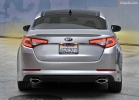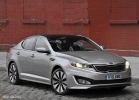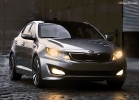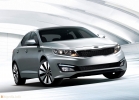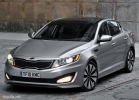Test drive Kia Optima (K5) since 2010 sedan
The strength of the argument
The premiere of Kia Magentis took place 5 years ago. Soon the car began to be produced in Russia, at the Kaliningrad Automobile Top. Two seasons later, barely noticeable changes have been made to the appearance, and now a completely new car produced in South Korea enters the market.The appearance of the first Magentis related to the European segment E can be considered a program statement by the Korean manufacturer. Kia Motors made it clear that she was not going to sit out in a cozy niche of budget cars. However, the price, of course, remains a strong argument. Thanks to the solidity and low cost, the car has become a favorite vehicle of middle hands, who are not supposed to travel to BMW and Mercedes-Benz.
If you compare the new Magentis with the predecessor, then the common features will not be able to find. Kia is more like Hyundai NF. The similarity can be traced in the form of a lateral part and stern. Not surprising. Both cars of the brainchild of one concern. The front of Magentis is somewhat reminiscent of Lexus models. Triangular headlights are striking, in the depths of which the lenses of near and high beam are hidden. The exterior is complemented by the elongated grille of the radiator, painted under chrome.
Despite the similarity of the newcomer with the NF model, his platform was borrowed from the bankrupt British company MG. As a result, the machine became higher by 7 cm, and the wheelbase expanded by 2 cm. At the same time, the volume of the luggage compartment increased to 420 liters. If desired, you can completely or in a ratio of 60/40 fold the rear seat, but the floor in this case turns out to be uneven, and the resulting hole can hardly be called large. So for the transport of overall goods, Magentis is not suitable, but this is not required of a real representative sedan.
In the car of the car, work on which was carried out simultaneously in Korea, the USA and Western Europe, you understand that the new Magentis has become a real representative of the business class. Therefore, you need to sit here not in front, but on a convenient rear sofa. We notice that the salon added in size. There are plenty of space over the head and for the legs. If desired, you can take a reclining position.
The quality of the materials grew by an order of magnitude. A plastic application under a tree disappeared from the interior, which greatly reduced the salon. In its place came modern inserts for aluminum in the High-Tech style. Plastic parts took a aesthetic look and became pleasant to the touch.
Unfortunately, test pilots have 5 wheel drives of personal drivers. So, we move forward and evaluate the driver's place. It was not possible to get a job right away. Every now and then there is not enough control range. This is especially true for the steering column.
The upper part of the dashboard has become soft. True, the plastic of the steering wheel and the gearbox lever disappeared. It seems that the skin was simply ripped off from these elements. Apparently, leather upholstery will really appear on more expensive options.
Governing and control bodies are conveniently located. They can be called intuitive. Literally in a matter of minutes, hands accurately turn on and turn off the necessary devices. There are three liquid crystal display on the central console. On the upper itself, the current time and information about the unsastened passengers are displayed. Separate attention is required by the system of notification of the undistrusted driver. It is enough to start the engine, as the nervous system will be excited by the opposite squeak. Safety, damn it! In the center of the console, the display of the CD player. A little below the screen with indications of climate control settings. To display current information, including the temperature of the engine and the amount of fuel, the LCD displays are also used. All these scales, numbers and badges glow with a pleasant blue light. It remains to add that the dials of the tachometer and speedometer received a chrome edging.
Starting the motor is accompanied by an inconspicuous shudder of the body. Extraneous sounds, so as not to bother the passenger on the back sofa, practically do not penetrate the salon. It is known that a separate job was conducted over the noise insulation of Magentis. The sound of the engine can only be heard when overcoming the mark of 5000 min-1. By the way, while dealers can only be found with a 2-liter gasoline engine, but soon version 2.7 will go on sale. Perhaps in Russia a 2-liter diesel is also debuted, but when this will happen, it is known only to senior marketers.
The dynamics of the 145-horsepower engine can hardly be called outstanding. But does a solid sedan need it so much? It does not add agility, but it facilitates the life of the driver in the metropolis automatic gearbox. There is also a manual speed switching regimen, which, however, does not accelerate acceleration. The car, as it were, sets up on a moderate, unhurried movement.
During maneuvering, the steering wheel is somewhat lacking feedback. But the trajectory of movement is clearly traced. The suspension works well with any irregularities, the car holds the way in corners perfectly.
The impressive overhangs of the bumpers are compensated by a solid clearance. And Magentis was pleased with maneuverability. With a length of more than 4.5 meters, it easily unfolds on a two -lane road.
The old version could be purchased for $ 17 thousand. The novelty costs at least $ 24 thousand. Now the basic configuration includes ABS, the course stability system, six airbags and seat belts. The competitors of the Korean debutant can be considered Toyota Camry, as well as a fellow for the Hyundai NF concern. Moreover, Magentis turns out to be the cheapest, not inferior to rivals in technical equipment.
+ Spacious salon, good sound insulation.
Mediocre dynamics, noisiness of the suspension.
Technical characteristics Kia Magentis
Equipped mass, kg 1491
Complete mass, kg 1920
Dimensions (length/width/height), mm 4735/1805/1480
Base, mm 2720
Maximum speed, km/h 195
Acceleration time to 100 km/h, from 11.2
Control consumption of fuel, l/100 km:
- City cycle 10.8
- Mixed 8.1
Fuel tank volume, l 62
Engine:
- The type is gasoline
- working volume, cm3 1998
- Power, L.S. at MIN-1 145/6000
- Torque, NM at min-1 193/4250
Transmission automatic., 4-speed
Brakes:
- front disk, ventilated
- rear disc
Price, $ 24,000
Text: Maxim Egorov
Source: Magazine 5 wheel [06/2006]

